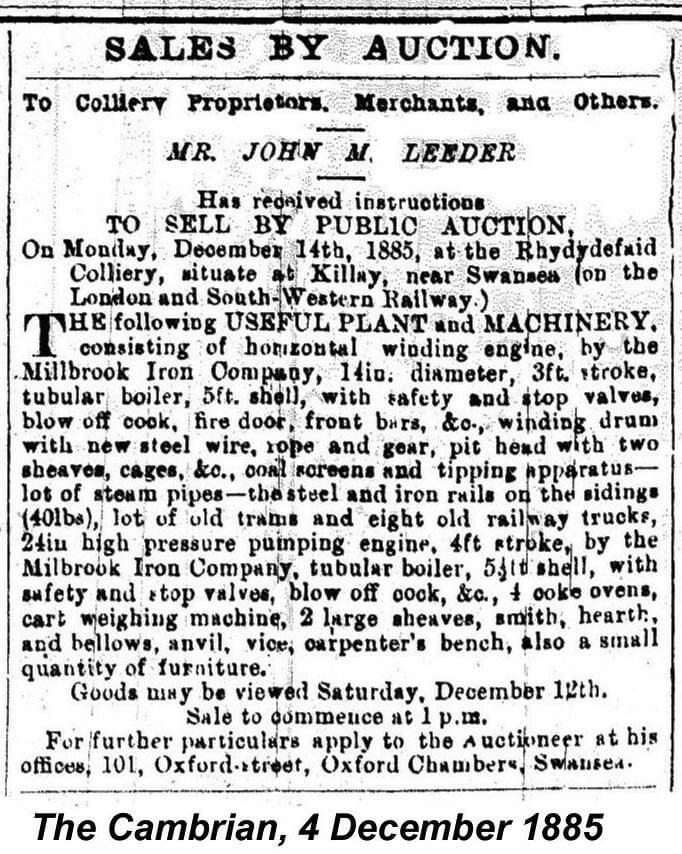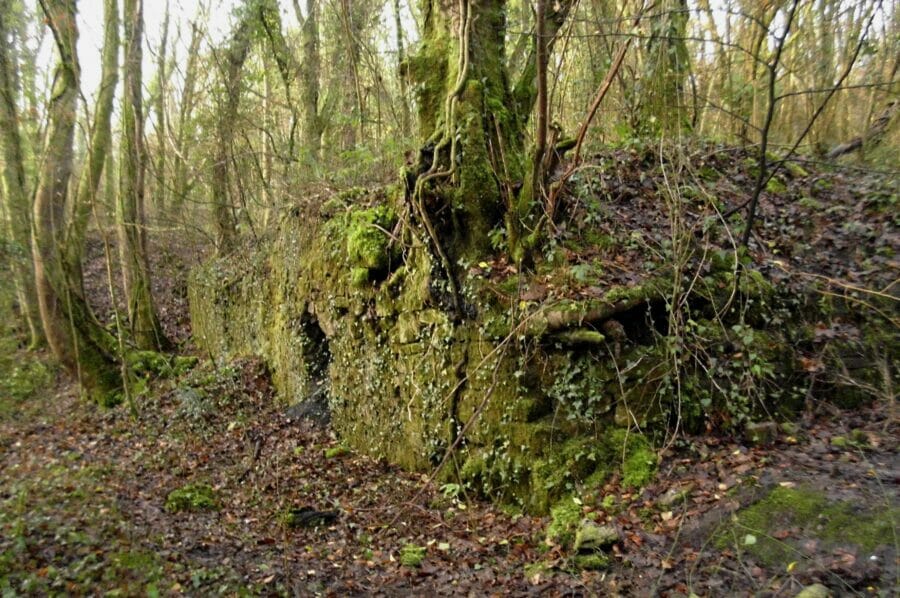Introduction
This pit is shown on the first edition of the 6in and 25in Ordnance Survey maps (1876-7). It can be identified with the shaft (capped with old rails and concrete) and associated derelict structures beside the steps between the Rhydydefaid boat level and the former brickworks. Whatever remains there may have been of the associated engine-house which housed the winding engine and which is shown a short distance to the north-east on the first 25in Ordnance Survey map are buried under a later tip of waste from the brickworks. Similarly, there are no visible remains of the pumping engine house to the south-west or of the associated coke ovens. The colliery’s extensive waste tips can be seen to the north of the pit on the south-east side of the embankment leading to the later Commercial Colliery.
The date of sinking can be placed in the early 1840s. In 1840 Sir John Morris II (1775-1855) demised 1,500 acres of land on the eastern side of the Clyne valley in the vicinity of Sketty Park to his son, George Byng Morris (1819-1899); including 500 acres under which coal and ironstone were located in quantities sufficient to justify commercial exploitation.
George Byng Morris started to work the coal and ironstone almost immediately through the Rhydydefed Coal Company and the Rhydydefed Iron Company which were created for this purpose. In order to serve these new workings, he re-laid the original 1804 Clyne valley branch of the Oystermouth Railway and extended it to Rhydydefaid pit in 1841-2, thus almost doubling its length.
Rhydydefaid Pit (later known as Rhydydefaid No. 1 or Old Rhydydefaid) was definitely in production by 1843 when a fatality in the pit was recorded. In 1845/6 the Rhydydefed Coal Co paid tolls on the Swansea Canal equating to 44 boatloads or 928 tons for coal supplied to the copper smelters of Landore. Unfortunately, this is the only year for which such figures are available. The deposited plans of the Cameron’s Coalbrook Steam Coal and Swansea & Loughor Railway Company of 1845 show a ‘colliery engine house, coal yard and sheds’ at a site which matches that of Rhydydefaid pit on later Ordnance Survey plans. The same plans also show that George Byng Morris had a coal yard at Blackpill for land sales. The pit is also shown on the deposited plans of the Swansea Docks & Mineral Vallies [sic] Railway of 1854 and the Llanelly Railway of 1860. A section of the pit prepared in 1846 shows that by that date it had reached a depth of well over 400 ft. It has been suggested that the pit was originally powered by water from the New Mill leat but the evidence for such a water engine is weak and seems to derive from a misunderstanding of the origins of the south-west arm of the leat. In any case, there was a steam engine at the pit by 1855 (see below) and it is reasonable to suppose that it had been there since its beginnings almost fifteen years previously.
In 1854 the Swansea Coal and Iron Co was formed, its directors all based in London. Its purpose was to ensure a cheap and reliable supply of coal for the shareholders and to provide them with a financial return by selling the surplus production. The company took a lease from George Byng Morris of 1,200 acres of coal in Sketty Park but there is no evidence that it ever worked any coal. It was replaced by a new joint stock company, the Rhydydefed Colliery Company Glamorganshire Ltd, which was formed in 1855. Its promoters were named as Major-General Sir James Charles Chatterton, Bart., of Limerick (who had been on the board of the earlier company) and Thomas Christopher Tatham. Later events show that Tatham was the real instigator of the limited company and its most active director. Yet another company was registered on 23 July 1856 under the title of the Rhydydefed Colliery Co Ltd. There is no reason to suppose that this represents a real change of ownership (except in a strictly legal sense), for Tatham was still named as the owner of the colliery in 1858 and again in 1861.
Some form of reconfiguration or re-equipping of Morris’ original pit was undertaken by Tatham’s company as is shown by an advertisement of 1855, which offered a steam engine for sale, the purchaser was required to remove it immediately since the proprietor required the site. The work was under the control of the mineral surveyor William Rosser (1829-1894) who later became a prominent figure in Llanelli as an agent to the Stepney estate. As part of the redevelopment, the Oystermouth Railway was re-laid with edge rails in place of the original tramplates. Conversion of the line from Rhydydefaid to Ynys was undertaken by the coal company and from Ynys to the Strand in Swansea by George Byng Morris. By September 1856 the new works, whatever they might have been, had been completed and the company started to market its coal which was described as ‘bituminous, of excellent quality and well adapted for House, Gas, Mining, Smiths and Coking purposes’. In addition to coal, it is known that they also produced ironstone.
The Rhydydefed Company worked the colliery until early in 1862 when it ceased operations. It was still working in December 1861 when two colliers were killed in a roof fall, but in a parliamentary return of February 1862 the company is listed among those that ‘ … have been dissolved, or have ceased to carry on Business, or have been ascertained … to be no longer in Operation’. An advertisement in December 1862 announced that all the plant at the Rhydydefed colliery would be auctioned in the following January. A return to the House of Commons dated 5 April 1864 states that the company had been wound up, but without giving the actual date.
The property reverted to George Byng Morris in 1862 following the failure of the Rhydydefed Co and he remained in actual possession until 1868 or 1869. Morris is named as the owner in Mineral Statistics for 1868, but in 1869 William Evans & Co is named as the owner, which implies a grant from Morris in 1868 or 1869. This company can probably be identified with the W & T Evans who, as the Tyr Glandŵr Coal Co, also worked Tyr Glandŵr colliery in Landore from c1868 to 1881 and the Voylart colliery at Dunvant between 1871 and 1877. For some reason, Evans & Co seem to have given up almost as soon as they started for there is clear evidence that in July 1869 Morris granted the colliery to Rhys Jones of Llanwrtyd Wells for eight years. Jones was named as the owner in a court case of February 1870 and was still in occupation in June 1870 when permission was granted to break through the barrier with Clyne Wood Colliery following an agreement between the Clyne Wood Colliery Co and Jones for the latter to work their colliery as part of Rhydydefaid. Jones seems to have given up very quickly, for Philip Richard is named as the owner in the 1870 Mineral Statistics.
The Llanelly Railway Co started to build their line through the Clyne valley in 1863 and opened it to goods traffic in 1865. The siding to Rhydydefaid pit was very probably put in at the same time. Philip Richard (1844-1912) was the son of Philip Richard (1813-1876), the partner of John Glasbrook who was a major figure in the Swansea coal industry in the second half of the 19th century. Philip Richard II subsequently went on to operate collieries at Dunvant, Fforestfach (Gendros, Weigfach, Weigfawr and Worcester) and Killay (Cae Bryn and Commercial). He introduced a steam locomotive on the Clyne valley branch – although it could well be those earlier operators of the colliery who had also used steam without any evidence for this practise has survived. Accidents are recorded throughout this period in the reports of the Inspectors of Mines and in The Cambrian, with Richard named in every case as the owner.
Evidence for the closure date of the Rhydydefaid pit is ambiguous. The colliery is listed in the report of the Inspector of Mines for 1882 and in Mining and Mineral Statistics for 1883. It is absent from Mining and Mineral Statistics in 1884 but re-appears in 1885 and 1886: in both years no manager is named which could be taken to indicate that it was inactive. The pit had definitely been abandoned by 1885 since all the plant and machinery was offered for sale in December of that year. The plant included a winding engine and a pumping engine, each with its own boiler; these would have been housed in the two engine houses which were marked on the 6in and 25in Ordnance Survey maps of 1876/7. There were also screens and tipping apparatus, cages, coke ovens (again as shown on the Ordnance Survey maps), a large number of trams, eight railway trucks, rails and a variety of miscellaneous equipment – altogether what one would have expected of a well equipped colliery. With a life of about forty years, its closure must have been due simply to the fact that all the coal that could be worked conveniently or economically had been extracted.

Fifteen veins had been encountered in the pit by 1846. Of these the most important were the Fiery, the Frog Lane, the Four Foot, the Yankee and the Three Foot. The other veins were unnamed and in most cases less than a foot in thickness. By 1868 four veins were in production, the Lower Four Foot, the Five Foot, the Frog Lane and the Fiery. In 1881 it was working the Two Foot, Three Foot, Five Foot and Four Foot. Whilst Richard had closed Rhydydefaid pit he had not surrendered his lease of the Sketty Park minerals and he subsequently took steps a few years later to open up the coal under a different part of the estate by means of Rhydydefaid No 2 or Commercial Colliery.

